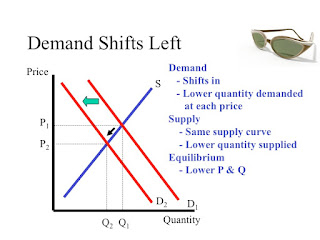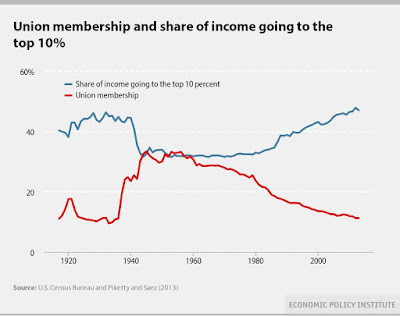Unit 2 - Microeconomics
Chapter 4 - Demand and Supply
Key Concept
From Chapter 4 the concept that was emphasized was Supply and Demand as well as when there was a surplus or shortage. Specifically when a price is set above the equilibrium point-above the point where supply meets demand- there will be a surplus. If the price is set below the equilibrium point there will be a shortage.
From Chapter 4 the concept that was emphasized was Supply and Demand as well as when there was a surplus or shortage. Specifically when a price is set above the equilibrium point-above the point where supply meets demand- there will be a surplus. If the price is set below the equilibrium point there will be a shortage.
Chapter 5 also, introduced the specific factors that shift the two curves. Factors that shift the demand curve are income or consumers, population, tastes and preferences, expectations and the prices of substitute goods. Factors that affect the supply curve are Number of sellers, Technology, Nature of the environment and the prices of related outputs.
Chapter 5 - Applications of Demand and Supply
Key Concept
The previous chapter introduced the concept of supply and demand however it didn't touch on the concept of elasticity. Chapter 5, focuses mainly on elasticity and the factors that affect demand and supply elasticity. Elasticity is defined as the responsiveness of quantities demanded and supplied to changes in price. The factors that affect demand elasticity are availability of substitutes, nature of the item, fraction of income spent on the item and the amount of time the product is available. The factors that affect supply elasticity are time, ease of storage and cost factors.
Chapter 6 - Business organizations and Finance
Key Concept
Chapter 6 provided an in depth summary of the different business organization. I was particularly interested in the corporation form of firm however the chapter also outlined all of the other forms of firms. The firms presented in the chapter consists of sole proprietor, partnerships, corporations, co-operative enterprise, government enterprise, non-profit and Charitable organizations. In the chapter the advantages and disadvantages were outlined for each organization making it clear and concise. Personally, a corporation interested me the most because there are a lot more resources as well as a larger impact that a corporation can have on a community. If the appropriate individuals are at the top of the organization then the corporation should be profitable and possess a good reputation.
Chapter 7 - Production, Firms and the Market
Key Concept
Chapter 7 provided an overall, very clear and detailed blueprint of "How Firms Think." This concept influenced me the most because it was easy to understand and to connect to every business operating today, like the principal that every business follows. The theory of the firm was the most impactful as it made it clear as to how firms operate and set goals.
Chapter 8 - Resource Economics: The Case of Labour Economics
Key Concept
For chapter 8 the concept that I felt was most important was the labour unions. The fact that labour unions are very equally divided in their pros and cons makes the issue very controversial. Specifically there was a trend between the decline of labour unions and the increase of income inequality. This ties later to chapter 15 which covers income distribution however, the decrease in the number of labour unions has dramatically changed the workplace environment. Without the unions bargaining between employers, the amount of power put into the hands of the employer has increased significantly, allowing employers to do whatever they please.
Unit 2 - Reflection
Unit two covered the basics of microeconomics and had many very important concepts covering many different areas in each chapter. The concepts I chose above reflect what I think and feel were most important about each chapter. The concept of supply and demand in chapter 4, gave an idea of how economics can be very precise in their field of business. Chapter 5, outlined elasticity which added on to the concept in chapter 4 however, in this chapter the key concept was that different products have different elasticities and price changes can either significantly affect or not affect the buying pattern of consumers. Chapter 6 and 7 outlined the business organizations, what their goals are and how they conduct business. Finally, chapter 8 took a look into labour and human capital as an economic resource. This knowledge has now given me the ability to recognize trends of the similar topic in not only businesses news today but any news.














Thank you.
ReplyDelete